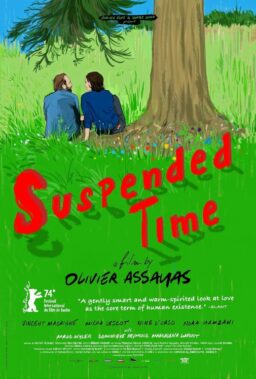“Onoda,” subtitled “10,000 Nights in the Jungle,” tells the story of the real-life figure Hiroo Onoda, a Japanese soldier who spent nearly 30 years in the Philippines living out what must be a record-setting case of denial: He didn’t believe that World War II had ended, and he continued to fight for the Imperial Army on Lubang Island—sometimes even killing civilians, according to accounts—until 1974.
Technically, “Onoda,” a whopping French-Japanese-German-Belgian-Italian-Cambodian co-production that is mostly in Japanese, is a biopic, but it never plays like one. This austere, bleak, occasionally even darkly funny film is, at nearly three hours, more like an absurdist slow burn. It’s always a little cute to assume that the programmers selected films to hold up mirrors to the festival experience. But here at PandemiCannes, where “Onoda” opened the Un Certain Regard section, and where elite audiences reportedly continue to carry on as if things were normal by flouting mask rules, this portrait of a man who chose to shut out the outside world had an eerie resonance.
Still, “Onoda” has a more pressing relevance to a world with Qanon and other proliferating, self-reinforcing conspiracy theories whose followers have the apparent ability to assimilate any countervailing evidence. To judge from the movie, directed by Arthur Harari (his best known credit in the United States might be as co-screenwriter of Justine Triet’s “Sibyl“), Onoda kept World War II alive in his mind in a similar way: by rationalizing any sign of the war’s end as a ruse. He thinks magazines and radio broadcasts are faked. In one of the wryer bits, he and a comrade decipher what they think is an elaborate code and conclude that they’re being ordered to a spot on the southern shore of the island. (“It’s all totally coherent,” one of them says after they’ve finished their convoluted decryption techniques.)
In the telling of the film, part of Onoda’s capacity for self-delusion was taught: Recruited for secret training by a major, Taniguchi (Issey Ogata), apparently because of—not despite—his fear of death, Onoda (played as a young man by Yuya Endo and as an older man by Kanji Tsuda) joins a recruit class of fellow ne’er-do-well soldiers for training in “secret warfare.” They’re instructed that one of the rules is that they “don’t have the right to die.” (For others, it might be an honor.) Another rule of secret warfare? Each recruit should act as his own commanding officer—a guideline that Onoda, tasked with leading a guerrilla-style mission on Lubang, really runs with. Split off from the rest, he and a small band of followers give names to various parts of the island and cultivate their own mythology.
But as wild as the story is, “Onoda” keeps things grounded with a commanding physicality. (In some ways, it suggests both the war films and the allegories of Sam Fuller.) It was shot by Harari’s brother Tom, who does wonders with natural light, and in a scene that truly defines commitment to the bit, Onoda is at one point shown sucking the maggots out of a wound. It’s hard to see how any man once afraid of dying could do that.
To the extent that my festivalgoing day had a theme, it was “movies about writers struggling to empathize with an unfamiliar perspective, starring eminent French actresses.” That’s a mouthful, but it really does apply, times two. François Ozon returned to the Cannes competition with “Everything Went Fine,” billed as “freely adapted” from a book by the French writer Emmanuèle Bernheim, a sometime Ozon collaborator who died in 2017. The book concerned Bernheim’s relationship with her father.

The film, which stars Sophie Marceau as Bernheim, begins with her receiving a call informing her that her dad, André (André Dussollier), has had a stroke. Partly paralyzed, unable to function on his own, he soon makes what she regards as an unthinkable request: He wants to die by assisted suicide. And over the course of the film, as Emmanuèle and her sister, Pascale (Géraldine Pailhas), grapple with whether Emmanuèle should accede to his wishes—it’s significant that he’s asked her and not Pascale—he remains resolute, wavering only once, by my count, so that he can see his grandson perform in a clarinet recital.
While end-of-life care raises a host of complicated issues that many people understandably put off dealing with as long as they can, Emmanuèle’s perspective initially seems strangely blinkered. Obviously, she doesn’t want her father to die, but the way Ozon presents the character, for a long stretch of the film it’s as if she doesn’t even recognize how much he is struggling, and why he might believe it’s time to go. The seeming one-note dynamic softens as the film goes on, as back story emerges. André married Emmanuèle’s mother (Charlotte Rampling) despite his being gay. She has long been debilitated herself, from Parkinson’s disease. André is upset by the attempts of a lover, Gérard, to visit him.
“Everything Went Fine” gathers momentum as what André calls “D-Day” approaches. André cannot die by assisted suicide in France—by law, he is not suffering enough—and so he must travel to Switzerland, where a woman played by Hanna Schygulla (not seen enough in this movie, or most movies) will make the arrangements. Certain elements of the drama, such as the extended family’s history with the Holocaust, and how the concept of Holocaust survival might affect the decision to die, are only cursorily addressed, and reading about the real-life figures, and Ozon’s friendship with Bernheim, unquestionably deepens the film in retrospect for those who—like me—went in with little knowledge of the project’s genesis. Whatever its flaws, “Everything Went Fine” rallies with a beautiful final act, cutting to black at a moment that is simple but devastating.
Another writer is the main character of “Between Two Worlds,” directed by the French author (and occasional filmmaker—he made 2005’s “La Moustache”) Emmanuel Carrère. The film opened Directors’ Fortnight, a parallel festival started in 1969 as an anti-bourgeois alternative to Cannes, although the film itself is a Ken Loach–like social-issue drama with a pointedly, and at times oddly, bourgeois perspective. Juliette Binoche plays a woman who, at the outset, appears to be a job-seeking housewife. She went to law school decades ago but never exercised those skills. A job counselor says that she’s cut out strictly to be a “maintenance agent,” the new euphemism for cleaning woman.

But Binoche’s character, Marie, is, it’s eventually revealed, not a housewife at all but a writer, who wants to understand the lived realities of unemployment and poverty by experiencing them herself. (The film was inspired by a book by the French journalist Florence Aubenas.) Going to work scrubbing toilets in Caen, France, she eventually finds herself employed where all of the area’s most desperate workers go: on a ferry that departs nearby Ouistreham, France, for Portsmouth, England, and where the work is so extensive and strenuous that workers are expected to clean 230 bedrooms—from bunks to first-class—at a speed of four minutes per room.
During her subterfuge, Marie befriends two women, Christèle (Hélène Lambert) and Marilou (Léa Carne), and her lack of journalistic ethics—she writes about Christèle’s experiences without ever identifying herself as a mole—becomes a sticking point. Would she still to be willing to clean toilets with them once she has a sensational book on her hands? “Between Two Worlds” is an adequate muckraking drama that avoids the hectoring tone of certain recent Loach films. That said, I did wonder whether the demographics of the low-wage workers (overwhelmingly white and French-born in this movie) were accurately depicted.
I don’t have a segue to Todd Haynes’ documentary “The Velvet Underground,” which premiered today out of competition and has little in common with the day’s other movies—and also mercifully little in common with a typical music doc. Haynes, a master deconstructionist (who already tipped his hat to the Velvet Underground to some degree in “Velvet Goldmine“) delivers the band’s much-told story in ways that avoid the obvious while probing pretty deeply. We never explicitly hear the adage about how everyone who bought The Velvet Underground & Nico formed a band, for example. Rather, we get hands-on analysis from people like the singer-songwriter Jonathan Richman, who actually did so, and who expounds in detail on what made the band’s sound unique. He recalls once being at a concert where an audience waited a full five seconds in stunned silence—Richman pauses and counts to five for effect—before applauding.

More to the point, “The Velvet Underground” isn’t just the story of the band, or at least not in intuitive ways. The surviving members are both wonky and funny: John Cale discusses how the most stable sound they could tune to was actually the “60-cycle hum of the refrigerator.” Maureen Tucker, the Velvet Underground’s drummer, launches into a rant about hippies (“this love-peace crap—we hated that”) when discussing the band’s first West Coast appearances.
But what’s most galvanizing about the film is how it anchors the band’s experimentation in the art scene of New York of the 1950s and ’60s. Regular visitors to Andy Warhol’s Factory like Mary Woronov and the film critic Amy Taubin share memories of the scene and the art it produced. The film is dedicated to the avant-garde filmmaker and promoter Jonas Mekas, who died in 2019 and is also featured extensively.
Early on, there was a moment when I wondered if most of the film would be told in split screen à la Warhol’s “The Chelsea Girls.” It isn’t, but Haynes’ continuous splitting of the frame doubles both as a Warholian homage and as a means of cramming a lot of stuff into a 110 minutes. Haynes draws on Warhol both for visual material and visual inspiration. Even interviews that might sound standard-issue engage the eye as well as the ear. (The cinematographer Ed Lachman clearly shot the talking-head segments with tremendous attention to color and pose.) “The Velvet Underground” draws on a treasure trove of archival material, including Factory screen tests, the films of Jack Smith and Mekas, and even an old TV clip of Cale talking about Erik Satie. And of course, it’s a great-sounding documentary, too. See it in a theater with good audio, and you will actually vibrate when “Heroin” kicks in.











